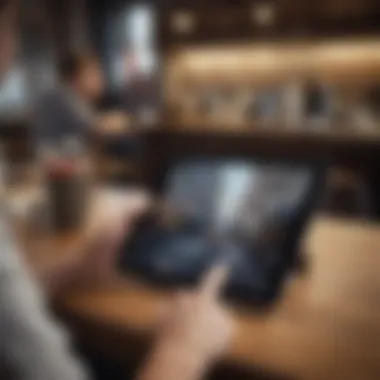Mastering Letter Composition on iPad: A Complete Guide


Intro
In modern times, the ease of composing a letter can greatly define one’s professional communication. With the iPad's sleek design and powerful capabilities, users are finding it increasingly convenient to compose letters right from the palm of their hands. This guide is tailored for anyone wanting to harness the potential of their iPad for creating written content, be it a personal note or a formal business letter.
The iPad's user-friendly interface combined with a plethora of apps offers a fertile ground for productivity. Whether you are just starting out or are well-versed in high-tech gadgets, an understanding of how to navigate this device effectively can elevate your writing experience substantially.
In the following sections, we will delve deep into various strategies, tools, and techniques specific to letter composition on an iPad, helping you master the art of typing and printing with efficiency and flair.
Prologue to Letter Writing on iPad
In a world where communication increasingly flows through pixels rather than paper, understanding the nuances of letter writing on an iPad has become ever more relevant. Whether you're crafting a professional business proposal, a heartfelt note to a friend, or an official correspondence, the ability to type and print letters directly from your device streamlines the process significantly. This guide is designed to enhance your comprehension of the various layers involved in this task, particularly how an iPad can serve as both a canvas and a typewriter.
Writing letters is not just about sending information; it's an art form that embodies clarity, intention, and personal touch. The exploration of this topic goes beyond technicalities. It dives into how an iPad, with its array of applications and features, can facilitate a seamless writing experience that caters to diverse needs. This guide does not merely highlight the functionalities; it also provides you with insights on efficiency and effectiveness. By mastering this skill, you can elevate your communication to a new level.
Understanding the Purpose of Letters
Every letter serves a distinct purpose, ranging from sharing updates to expressing feelings. In the digital age, mastering letter writing entails recognizing these different intents. Letters can strengthen professional relationships by providing a formal avenue for communication. They can also convey warmth in personal relationships, irrespective of how far apart you may be. A well-composed letter encapsulates not only the message but the sentiment behind it.
It's this blend of functionality and emotion that makes mastering letter composition worthwhile. This comprehensive guide assists you in organizing your thoughts and expressing them succinctly. With clearly defined purposes in mind, your letters will resonate far better with your audience.
Benefits of Using an iPad for Typing
Utilizing an iPad for letter writing holds numerous advantages. Firstly, its portability allows for writing on the go, making it easier to jot down thoughts whenever inspiration strikes. You can easily pull it out in a café or a meeting without the cumbersome nature of a laptop.
Moreover, with a variety of applications at your disposal, such as Apple's Pages or the minimalist Notes app, the choices can cater to your specific needs. You may prefer a streamlined interface for quick drafts or a feature-rich environment for more detailed letters. This adaptability helps streamline your writing process, allowing you to focus without unnecessary distractions.
Furthermore, the virtual keyboard, when adjusted to your liking, makes typing smoother and more natural.
- Ergonomics: An iPad frequently enables a more comfortable typing position.
- Compatibility: Many apps support seamless integration with cloud services for ease of saving and sharing.
Here’s a key takeaway to consider:
"Using an iPad combines the benefits of traditional writing tools with advanced technology, facilitating a modern writing experience that feels intuitive and collaborative."
With all these features, what's important is how you leverage them uniquely to shape your writing style and process. This article will help you explore these advantages fully, and in turn, make your letter writing not only easier but also more enjoyable.
Choosing the Right Application
When embarking on the task of letter writing on your iPad, selecting the right application is pivotal to streamline the process and elevate the quality of your work. The right app not only simplifies writing but also offers features that cater to your specific needs, whether they are creative, business-oriented, or personal. The choice of application can make a significant difference in productivity, usability, and the overall experience of composing letters.
One must consider various aspects when choosing an application. Look closely at what each app offers; for instance, are you inclined towards simplicity, or do you need more advanced formatting tools? What about collaboration features? Different applications cater to different user profiles. Some may find that a basic app is sufficient for jotting down quick notes, while others might require a more robust suite to handle intricate designs and layouts.
Moreover, compatibility and synchronization across devices should never be underestimated. Choosing an app that seamlessly integrates with your other devices ensures you can access your work anytime, anywhere. This interconnectedness becomes particularly important when dealing with important correspondence that may require revisions on the fly.
"Selecting the right tool can often dictate the success of your task, especially in writing. Choose wisely, and the process will flow like water through a well-laid channel."
Native Apps: Notes and Pages
Apple's native applications, namely Notes and Pages, serve as excellent starting points for anyone looking to compose letters on their iPads. Notes, characterized by its stripped-down interface, allows users to quickly write down thoughts, ideas, or casual correspondence. It's straightforward and easily navigable, appealing to those who prefer minimalism.
However, if you're aiming for a more polished letter, Pages is where you'll find a treasure trove of features. With Pages, users can choose from several professionally designed templates. This app supports advanced formatting options and text styles, making it suitable for creating formal letters or elegant invitations. It also allows for easy incorporation of images and tables, which can enhance the overall layout of your correspondence.
Both apps can sync with iCloud, ensuring your documents are accessible across your Apple devices. This feature means that whether you begin a letter on your iPad and finish it on your Mac, you’ll never lose track of your thoughts.
Third-Party Applications
While Apple's native solutions provide a solid foundation, third-party applications often deliver additional functionality. Microsoft Word, for example, brings a familiar interface to users who are used to traditional desktop environments. Its extensive formatting capabilities along with powerful tools like Spell Check and collaboration features make it an ideal choice for professionals.
Moreover, Evernote offers unique advantages not found in other applications. Its organizational features allow users to group letters with related notes, creating a cohesive workspace. With powerful tagging systems and integration with other apps, you can customize your letter writing process further.
Users should look for applications that fit their specific writing styles and objectives. An app that's packed with features might seem attractive at first glance, but it can become a burden if it complicates what should be a straightforward letter-writing endeavor.
Comparing Features and Usability
Comparing various applications is crucial before settling on one. Start with a list of features relevant to your specific needs, such as templates, formatting options, and collaboration tools. Think about how each app feels during use: Is it intuitive? Does it respond to your touch effectively?
- User Interface: A clean, user-friendly interface can significantly affect writing speed and creativity.
- Customization: Check how much you can customize your documents; tweaking fonts, headings, and spacing can enhance the polish.
- Collaboration: If you need feedback or edits from others, can the app facilitate that smoothly?
- Support and Updates: Consider the developer’s reputation—are they known for regular updates and solid customer service?
Ultimately, the application you select should align with your objectives and workflow. The key is finding an app that feels right for you, allowing for creativity and efficiency to flourish in your letter writing. Choosing wisely here lays the groundwork for a rewarding and successful writing experience.


Setting Up Your iPad for Writing
Setting up your iPad to write letters isn’t just a matter of opening an app and typing. It hinges on fine-tuning certain elements to ensure a smooth, efficient, and enjoyable writing experience. A poorly configured device can lead to distraction and frustration, especially when clarity and professionalism are your goals. So let’s dive into the nitty-gritty.
Configuring the Keyboard
To get the ball rolling, let’s focus on configuring the keyboard. The iPad's keyboard is versatile, but it requires personal tweaks to truly harness its full potential. You might find it helpful to explore the keyboard settings in Settings > General > Keyboard. Here, you can enable options like Auto-Capitalization, Smart Punctuation, and even Predictive Text. These features can save you a lot of time, especially if you regularly send lengthy missives.
Also, consider switching between different keyboard layouts. If you're accustomed to a specific style, adjusting might provide you with a more familiar environment for writing. Some users might benefit from using the Split Keyboard option, which allows you to type with your thumbs easily while holding the device.
Don’t forget the enhanced features offered by third-party keyboard apps like Gboard or SwiftKey. They come with customizable shortcuts that can speed up your writing process. Choosing the right keyboard setup is akin to finding the perfect pen; it makes a world of difference in your letter-writing journey.
Adjusting Display Settings
Next up, is adjusting display settings. The quality of the screen’s readability can make or break your writing experience. Navigate to Settings > Display & Brightness to play around with brightness levels and contrast. A well-lit screen can keep your focus sharp and your creativity flowing. Think about also adjusting the Night Shift settings if you’re planning on writing late into the evening; it mitigates eye strain.
Moreover, the Text Size and Display Zoom features can be game changers. Larger fonts might help you spot typos more easily, which in turn leads to better editing. Likewise, experiment with the True Tone feature. By adapting the screen's color temperature to the light around you, it can make reading and writing far more comfortable.
If you’re prone to distractions, consider using Do Not Disturb mode. This helps to filter notifications during your writing sessions, allowing you to channel your inner wordsmith without interruptions.
Using External Keyboards
Finally, let’s address the option of using external keyboards. Many people may not realize the difference an external keyboard can make, particularly if you're serious about letter writing. Devices like the Apple Magic Keyboard or any compatible Bluetooth keyboard transform your iPad into a more traditional typing experience.
The tactile feedback from a physical keyboard can enhance your productivity, and it may even help in avoiding mistakes that a touchscreen might encourage. When setting it up, ensure that you’re in range and paired correctly through the Bluetooth settings:
- Go to Settings > Bluetooth.
- Toggle it on, and select your keyboard when it appears in the list.
Using an external keyboard not only increases comfort but could also improve typing speed. Furthermore, don’t hesitate to adjust the keyboard's position. A slight tilt or proper height can dramatically enhance ergonomics.
Remember: A well-set-up iPad is akin to a finely-tuned instrument; every adjustment is a note in the symphony of your letter writing.
In summary, setting up your iPad for writing involves more than meets the eye. Each configuration dramatically influences your efficiency and comfort. By taking the time to fine-tune these elements, you're investing in your writing prowess and paving the way for clearer communication in your letters.
Crafting Your Letter
Crafting a letter is more than just putting words on a screen. It’s about conveying your thoughts precisely and effectively. In the digital age, especially with devices like the iPad, this process has evolved but still holds the same weight as traditional writing. A well-crafted letter can open doors, whether for professional connections, personal correspondence, or formal communications. It shows that attention has been paid, not only to the content but also to the presentation. This section delves into essential elements that contribute to creating a compelling letter, including structure, formatting, and visual enhancements.
Structuring the Content
The foundation of any letter lies in its structure. Like building a house, if the base isn't solid, the rest will tumble down. When drafting your letter on an iPad, it’s vital to have a clear layout: introductory lines, body paragraphs, and conclusions. Here's a simple outline to consider:
- Opening Greeting: Address the recipient appropriately. If it's a formal letter, use titles like "Dear Mr. Smith"; for informal, something like "Hey Sarah" works.
- Introduction: State your purpose right from the get-go. This helps the reader understand why you’re writing without having to sift through the text.
- Body: This is where you lay out your main points. Use concise paragraphs for clarity. Break complex ideas into digestible pieces.
- Closing Statement: Wrap it up by reiterating your message or making a call to action. It keeps the reader engaged and informed.
- Sign-off: Depending on the relationship with the recipient, use formal sign-offs like "Sincerely" or more casual ones like "Best regards."
A well-structured letter can keep attention focused and convey professionalism. Missing out on these elements could result in the recipient losing interest before they even finish reading.
Utilizing Formatting Tools
Formatting isn't merely about making your letter look pretty; it enhances readability and emphasizes key points. With the iPad's variety of apps like Pages or Microsoft Word, users can easily access formatting tools to elevate their letter creation.
- Font Choices: Select clear, professional fonts like Arial or Times New Roman. Avoid decorative fonts unless you’re drafting something informal or fun.
- Font Sizes: Standard sizes, usually between 10 and 12 points, ensure your text is readable.
- Bullet Points and Lists: When presenting multiple ideas or key points, bullet points can help break up text and highlight information clearly.
Consider the use of bold or italic text sparingly for emphasis. Too much can be visually overwhelming, making your letter look messy instead of refined. Proper use of formatting can guide the reader's eye to significant parts without them even realizing it.
Incorporating Visual Elements
Adding visual components can provide a fresh angle to your letter, particularly if conveying complex information or data. On an iPad, integrating visuals might seem daunting, but it’s achievable with a few tips.
- Images: If relevant, include a high-quality image. This could be a logo for a business letter or even a relevant photo for personal letters.
- Graphs and Charts: For professional or academic communication, showing data visually can clarify your points. Apps like Excel allow you to create simple charts that can be exported into your letters.
- Spacing: White space is just as important as content. It gives the eye a break, making your text more inviting to read. Make sure to utilize margins and spacing adequately.
Incorporating visual elements thoughtfully enhances engagement and bolsters the message in your letter. Whether it's through images or charts, make sure they align with your intent and theme.
Reviewing and Editing Your Letter
Reviewing and editing your letter is the backbone of crafting effective communication on your iPad. It’s a step that cannot be overlooked or rushed. This phase is not merely about fixing typos or grammar; it’s an opportunity to refine your voice, ensure clarity, and strengthen your argument or message. When you take a moment to reflect on what you’ve written, you can identify areas that need improvement, ensuring that your letter resonates with the intended audience.
One of the main benefits of this stage is that it helps in enhancing professionalism. A well-reviewed letter transfers a sense of authority and consideration to the reader. If your letter is riddled with errors or unclear statements, it might leave a poor impression, regardless of the content. Moreover, editing allows for a deliberate choice of words, ensuring that the message is not only understood but also impactful.
When you review, remember that it’s not just about grammatical correctness. It’s crucial to consider whether your tone aligns with the purpose of the letter. Are you sounding too casual for a business communication? Or perhaps too formal for a friendly note? Nuances like these are often caught during the review process.


"The first draft is just you telling yourself the story." - Terry Pratchett
This quote emphasizes the idea that writing is an evolving process. Preventing yourself from getting too attached to your initial ideas may provide room for improvement and clarity. Here, we’ll delve into three sub-sections that focus on specific aspects of reviewing and editing your letter: utilizing spell check and grammar tools, receiving feedback, and making final adjustments.
Utilizing Spell Check and Grammar Tools
Spell check and grammar tools have evolved significantly over the years. On your iPad, applications like Pages or Word come built-in with these tools, allowing you to verify your writing with ease. Utilizing them can catch more than basic misspellings. They can alert you to common grammatical mistakes and suggest corrections.
However, it's important to remember that these tools are not foolproof. For example, they may overlook subtle nuances in context. A word spelled correctly but used inaccurately can still create confusion. Therefore, while spell check offers a safety net, it shouldn’t replace careful proofreading.
Here are a few tips for effectively using these tools:
- Adjust settings in your application to match your preference for style guides (like AP, MLA, or Chicago).
- Proofread your writing once more after relying on the tool, as the final human touch can unveil errors that automated processes miss.
- Practice typing with a focus on challenging spellings or grammatical structures to improve your overall writing competency.
This way, while you benefit from technology, you are also honing your skills as a writer.
Receiving Feedback
Another key component of the editing process is receiving external feedback. Having another set of eyes on your letter can expose blind spots, sparkling insights you might have missed. It’s best to enlist someone who can provide constructive criticism rather than just compliments.
Consider these approaches to getting effective feedback:
- Select a trusted peer or mentor who understands the topic and can provide valuable insights without bias.
- *Ask specific questions. For instance, inquire if certain parts are confusing or if the tone aligns with your intent. This will guide the feedback.
- Be open to suggestions. Even if a suggestion doesn’t sit well with you, consider it. Sometimes the most valuable shifts arise from ideas that initially seem contrary to what you envisioned.
Feedback offers a fresh perspective and enhances the depth of your letter. Incorporating it wisely can elevate your writing to unexpected heights.
Making Final Adjustments
Once you’ve implemented the feedback, the last step is making final adjustments. This doesn't mean altering everything; rather, it’s about fine-tuning your letter. Review whether the structure flows logically, ensuring each part transitions smoothly into the next.
Additionally, pay attention to:
- Consistency in tone throughout the letter. This is especially important if you modified sections after receiving feedback.
- Formatting tweaks, such as ensuring margins, spacing, and font choices are uniform and professional.
- Double-checking names, dates, and figures. A small error can have a significant impact, especially in formal communications.
Through revisiting your letter from both macro and micro perspectives during this final phase, you not only polish your work but also transform it into a beacon of clarity and professionalism.
In summary, reviewing and editing isn't merely a task; it's an essential process that amplifies the strength of your communication on the iPad. Being deliberate about this can lead to compelling letters that truly reflect your intent and professionalism.
Printing Your Letter
Printing may seem like a mere afterthought when writing a letter on your iPad, but it carries its own weight. The act of printing transforms your digital words into something tangible, allowing you to present ideas, feelings, or decisions on a page that can be held, read, and even cherished. Whether you're drafting a formal business letter, a heartfelt note, or anything in between, understanding how to effectively print your work can elevate the entire writing experience.
Connecting to Printers
Establishing a connection between your iPad and your printer is the first step to bring your words to life. Thanks to Apple's AirPrint technology, this can often be done swiftly and without a hitch. Here’s how to get connected:
- Ensure Compatibility: Before anything, check if your printer supports AirPrint. Most modern printers do, but it’s always good to double-check.
- Join the Same Network: Ensure that your iPad and the printer are both on the same Wi-Fi network.
- Access Print Options: Open your letter in your preferred app and tap the share icon. Select the print option and then choose your printer from the list provided.
Once connected, you're just a few taps away from printing your letter. Modern printers often have their own apps, which can provide additional settings and functionalities, but sometimes those native options do the trick just fine.
Choosing Print Settings
The print settings can make or break the final look of your letter. Here are factors to consider:
- Paper Size: Commonly, most letters use A4 or letter-sized paper. Make sure you select the right size.
- Orientation: Portrait versus landscape can affect readability. Typically, letters are printed in portrait.
- Quality Settings: You might have a choice between Standard and High Quality. Choose High Quality if it’s a formal letter to make a good impression.
- Number of Copies: If you’ll need more than one copy, don’t forget to specify that.
- Double-sided Printing: Some might prefer to save paper by printing on both sides. This option can be beneficial for longer letters.
"The right print settings can turn your writing into a polished piece that reflects your attention to detail."
Troubleshooting Common Printing Issues
Often, problems can arise when you attempt to print, knocking on the door of frustration. Here’s how to sidestep those issues:
- Printer Offline: If your printer shows as offline, check to ensure it’s on and connected to the Wi-Fi. Sometimes a simple restart can resolve the issue.
- Connection Errors: If you cannot find your printer in the list, confirm that both devices are on the same network. Disconnecting and reconnecting can help, too.
- Printing Quality Problems: If your letter prints with smudges or streaks, inspect the ink or toner levels and do a quick cleaning cycle if necessary.
- Document Not Printing: If your document fails to print, make sure there are no updates required for the app you are using or the printer itself.
Navigating these common hurdles can save you time and annoyance, ensuring that your polished letter prints just as you envisioned.
Saving and Exporting Your Letter
Saving and exporting your letter is a fundamental step in the writing process that often gets overlooked. This phase is crucial not just for safeguarding your work, but also for ensuring that it can be accessed and shared efficiently, leveraging the various capabilities of your iPad. If you’ve put pen to paper, or rather, fingers to screen, it’s essential to have the means to preserve your work, especially with the way technology constantly evolves.


When you save your letter, you're not just putting a pause on your writing; you’re making sure that all your thoughts and ideas are stored safely. Consider the headache that comes with losing several hours of work due to a dead battery or an unexpected crash. Regularly saving your documents acts as a safety net, preventing such mishaps from turning into disasters.
Moreover, exporting your letter allows you to share it beyond your iPad, giving it a life outside your device. Be it a formal letter for business or a heartfelt note to a loved one, having the right format ensures your message retains its essence regardless of where it's viewed. Different scenarios may call for different formats, and knowing how to handle these changes can elevate your communication.
Different File Formats
When it comes to saving and exporting letters, understanding file formats is key. Each format has its own strengths, weaknesses, and specific use cases.
- PDF (Portable Document Format) - This format is a favorite for many, as it keeps your document's layout intact. This is important, especially if you’re including images or specific formatting. PDFs are universally accessible, which makes them ideal for sharing.
- DOCX (Microsoft Word) - If you plan to edit your letter collaboratively or anticipate changes, saving as a DOCX can be beneficial. This format allows for easy editing and is compatible with various word processing applications.
- TXT (Plain Text) - Sometimes, simplicity is key. A TXT file lacks formatting but is highly portable and can be opened on virtually any device. This is useful when sharing with individuals who may be using different systems.
- RTF (Rich Text Format) - For those who need a bit of formatting without the complexity of other formats, RTF is a solid choice. It supports various styles and fonts but remains compatible across many platforms.
Being aware of these formats helps you choose correctly based on the intended use or audience, ensuring your letter communicates effectively.
Cloud Storage Options
In today’s digital landscape, using cloud storage options for saving and exporting your letters can offer significant advantages. Not only does it provide a safeguard against local data loss, but it also makes your work available from any device that can connect to the Internet.
- iCloud Drive - Seamlessly integrated with Apple devices, iCloud Drive automatically saves documents as you work. This means you can access your letter from your iPhone, Mac, or any browser with your Apple ID.
- Google Drive - For those who appreciate collaboration, Google Drive provides robust tools for sharing. Multiple users can view and edit the document at the same time, which is perfect for group projects or feedback processes.
- Dropbox - It is another reliable option for storage, offering easy sharing capabilities and good organizational features. With Dropbox, you can quickly access and restore previous versions of your documents if needed.
- OneDrive - This is particularly appealing if you’re also working with Microsoft products. OneDrive integrates well with the Microsoft ecosystem and allows flexible sharing options.
Best Practices for Letter Writing
When it comes to crafting letters on the iPad, embracing best practices can greatly enhance the overall quality of your writing. While the technical aspects of using an iPad for letter writing have been extensively covered, the manner in which you approach the content can significantly impact its effectiveness. This section delves into maintaining professionalism and incorporating personal touches, both of which are pivotal in ensuring that your correspondence hits the mark.
Maintaining Professionalism
Keeping a professional tone in your letters is a cornerstone of effective communication, particularly when addressing colleagues, clients, or other formal recipients. Here are some key points to consider:
- Be Clear and Concise: Brevity is crucial. Aim for clarity without unnecessary jargon. If your message is muddled by complex terms or fluff, it can lose its intended impact.
- Proper Structure: Organize your letter logically. Start with an introduction, follow with the body containing the main points, and conclude effectively. An easily navigable structure keeps the reader engaged and enhances understanding.
- Check for Errors: Utilize tools like spell check and grammar check features within your chosen app. An overlooked typo can tarnish your professionalism and diminish the message's sincerity.
- Appropriate Salutations and Closures: Customizing your greetings and sign-offs can display attentiveness. Consider the relationship with the recipient when choosing a salutation; a straightforward "Dear [Name]" often works wonders.
"Professionalism is not just about following rules; it’s about being respectful and demonstrating consideration for your audience."
In summary, professionalism in letter writing shapes how your communication will be perceived. Your choice of words, format, and attention to detail makes all the difference.
Incorporating Personal Touches
While maintaining professionalism is essential, adding personal touches can transform a standard letter into something more impactful. Personalization helps establish a deeper connection and makes your letters resonate with recipients. Here’s how to strike the right balance:
- Tailor Your Message: Mention specific details about the recipient or your previous communications. Quotes or references from previous conversations can make the letter feel more intimate.
- Use a Conversational Tone: While professionalism is key, don’t shy away from using a relaxed tone when appropriate. It can make your letters feel more genuine, reflecting your personality amid the formalities.
- Include Handwritten Notes: If you’re printing your letter, consider adding a handwritten note or signature. This small gesture can evoke warmth and sincerity that typed text often lacks.
- Express Gratitude: A simple thank you can go a long way. Acknowledging the recipient's efforts or contributions sets a positive tone and cements relationships.
Incorporating personal touches not only humanizes your letters. It signifies thoughtfulness, which recipients often appreciate. Finding that sweet spot between professionalism and warmth is the ticket to effective letter writing.
Frequently Asked Questions
In the world of iPad letter writing, there often lurks a fair share of uncertainties. This section addresses those burning questions that plague both newbies and seasoned pros alike. Frequently Asked Questions (FAQs) serve a dual purpose: they clarify common misunderstandings and streamline the writing process. Asking the right questions can illuminate pathways to efficiency that many users may overlook. Throughout this article, we'll encapsulate various concerns, offering insights that empower individuals to tackle letter composition with flair and finesse.
Common Challenges in Typing Letters
Letter writing on an iPad might seem straightforward, but it presents its own set of hurdles. Identifying these challenges is the first step towards conquering them. A few notable challenges include:
- Typing Speed: While touch typing has its fans, many struggle with the on-screen keyboard. Finding your rhythm can take more time than expected.
- Formatting Difficulties: Replicating traditional letter formatting can become a headache, especially when attempting to align text and incorporate headers.
- Limited Screen Real Estate: Juggling multiple apps and windows can be cumbersome. It’s easy to lose your train of thought when shifting back and forth without adequate multitasking capabilities.
- Document Management: Keeping track of your letters and drafts can feel chaotic. Different apps may have varying organizational systems, adding to confusion.
These challenges can deter users from utilizing their iPad effectively. However, understanding them enables users to explore solutions that can enhance their writing experience.
Alternative Solutions for Efficient Writing
When faced with obstacles, seeking alternative solutions becomes essential. Luckily, the iPad offers a plethora of options to boost efficiency:
- Third-Party Apps: Applications like Microsoft Word and Google Docs present user-friendly interfaces while supporting collaborative features. These can handle advanced formatting with ease.
- Voice Dictation: Leveraging Siri or other voice recognition tools allows you to dictate your letters. It’s a handy feature that can save time and promote fluidity in your writing.
- Keyboard Shortcuts: If using an external keyboard, mastering shortcuts can prove to be a game-changer. Tasks such as copy-pasting or switching applications can be executed without lifting your fingers off the keys.
- Utilizing Templates: Many applications provide customizable templates for letters. They can effectively guide you through structure, saving time and ensuring a professional touch.
Utilizing these alternative methods can significantly reduce barriers and enhance your overall writing efficiency.
By addressing common challenges and exploring viable alternatives, iPad users can transform letter writing into a smoother, more enjoyable experience. Through practice and the right tools, proficiency can certainly be attained.
Epilogue
In wrapping up our journey through effective letter composition on the iPad, it’s crucial to reflect on the valuable insights presented. This guide isn’t just about punching keys; it illuminates the pathway to presenting thoughts clearly, whether in a professional context or a personal note. The ability to create, edit, and print letters seamlessly on an iPad showcases the versatility of this device, positioning it as a pivotal tool in today's digital communication landscape.
Recap of Key Points
The importance of mastering letter writing on an iPad can be distilled into several key elements:
- Versatile Tools: Familiarity with both native and third-party applications can greatly enhance the writing process. Apps like Pages and Google Docs offer varied functionalities, catering to different user needs.
- User-Friendly Setup: Configuring the iPad’s keyboard and display settings can create a conducive writing environment. External keyboards can further transform your device into a more traditional workstation.
- Attention to Detail: Crafting your letter involves not just text but visual appeal. Proper formatting and the thoughtful inclusion of images elevate the overall presentation.
- Efficient Reviewing: Utilizing spell check and grammar tools, alongside seeking feedback, can dramatically improve the letter's clarity and professionalism before hitting print.
- Printing Made Easy: Understanding how to connect to printers and choose optimal print settings ensures that your efforts translate into a tangible result without stress.
Encouragement for Continued Practice
While this guide provides a solid foundation, consistent practice is the key to honing your letter writing skills on the iPad. Whether you're a novice still finding your feet or a seasoned wordsmith, taking the time to draft and refine different types of letters can solidify your proficiency. Experiment with various apps, layouts, and drafting techniques. Moreover, embrace feedback from peers or mentors; fresh perspectives can shine a light on areas for improvement and encourage growth.
Remember, each letter is an opportunity to communicate effectively. So, keep those fingers flying across the screen and allow your creativity to flourish. Engaging with this practice will not only enhance your writing but could also elevate your overall digital literacy. By continuously evolving your skills, you remain well-equipped in both personal and professional communications moving forward.



